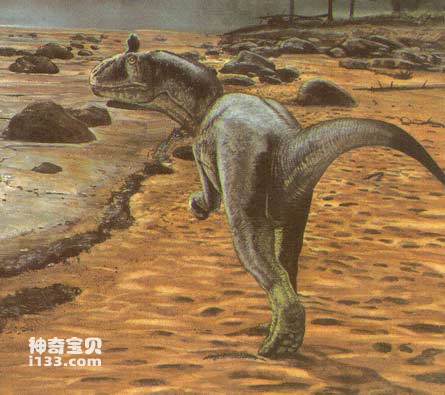We say that Dicrosaurus was the overlord of the early Jurassic because they were large carnivorous dinosaurs active on various continents, intimidating other animals in every corner of the world at that time, even including Antarctica, which is now a world of ice and snow. However, in Antarctica, the dominance of Dicrosaurus may have given way, because at that time, there was still a larger carnivorous dinosaur in Antarctica - Coolosaurus.
Antarctica in the early Jurassic was not what it is today, thousands of miles of ice. At that time, Antarctica was further north on the earth and had a warm and humid climate.

cool dragon
Because dinosaur fossils have been found all over the world, scientists have long believed that dinosaurs must have survived in Antarctica. However, it was not until 1986 that scientists discovered fossil evidence of dinosaurs in Antarctica. These dinosaur fossils buried under the snow-covered mountains now provide scientists with new clues for studying the morphology and living habits of carnivorous dinosaurs.
In the summer of 1991, American scientist Dr. Hamer and his colleagues discovered the fossil of a huge carnivorous dinosaur unknown to anyone at the time in the ground during an investigation on Mount Kirkpatrick, 400 kilometers away from the South Pole. This carnivorous dinosaur has a distinctive crest on its head, which looks a bit like the beautiful crest on a peacock's head. So cool! However, the crest of this dinosaur is not a crest of feathers like a peacock, but is formed by bone protrusions. Scientists named this dinosaur. The original Latin meaning is "crested dragon in cold areas". Ryuko, the museum's director, translated it as "cool dragon". On the one hand, it was taken from the "harsh" climate of "cold areas". On the other hand, it also means "the crown of the crest is different" and therefore "cool".
Cool Dragon is 7.62 meters long and weighs approximately 680 kilograms. Two types of carnivorous dinosaurs have also been discovered in Antarctica. One is very similar to the small Coelophysis that once lived in western North America, and the other belongs to the second largest carnivorous dinosaur in the early Jurassic - Dicrosaurus. Measurements show that Coolosaurus is 1.5 meters longer than the world's largest Dicrosaurus.
Research on Coolosaurus and other carnivorous dinosaurs shows that during the Jurassic, carnivorous dinosaurs had evolved towards larger sizes and more complex behaviors. The crests of Coolosaurus and Dicrosaurus are likely to play a role in opposite-sex attraction or same-sex competition in mating behavior. Like many modern animals, it is likely that only males had such a crest. Of course, these crests may also serve to scare enemies.
If the function of the crest is indeed for mating behavior, then how do carnivorous dinosaurs without crests like Coelophysis rely on to carry out social behaviors such as "courtship"? Scientists speculate that Coelophysis probably changed the color of its skin to woo the opposite sex. Other dinosaurs may have chirped to socialize.
How did scientists come to these assumptions about dinosaur social behavior? In fact, they are based on observations of many modern animals. Body shapes that serve solely as sexual display characteristics are common among modern animals. For example, male deer have large, complex-shaped antlers that they display when they raise their heads and bark to win the favor of female deer.
Characteristics of color display and behavior in modern birds, close relatives of dinosaurs. For example, when male peahens want to attract the attention of female peahens, they spread and flutter their colorful tail feathers. As for the cool dragon, it is likely that like the blue bird, when competing for territory with competitors, it stretches its head forward, showing its cool crest to tell the opponent: "This is my territory!"
Many living reptiles also display color behavior. Male and female lizards often look different from each other, allowing them to easily identify their sex from each other during mating season. Generally, males are more colorful than females.
When Dr. Hamer discovered the cool dragon, he remembered the flamboyant hair style of a Rolling Stones singer named Elvis, so he jokingly called the cool dragon "Elvis Dragon".
At Kirkpatrick Mountain, Dr. Hamer and other scientists also discovered an interesting phenomenon. They found some teeth from small carnivorous dinosaurs similar to Coelophysis in the fossil bones of Coolosaurus! A reasonable explanation is that some small carnivorous dinosaurs broke some teeth while eating the meat of the dead Coolosaurus. Cool dragons were the most fearsome predators in the world at the time, but they could also become prey to smaller predators. Could it be that the Coolosaurus, which is more than 7 meters long, cannot defeat the small Coelophysis? Scientists have not yet found sufficient evidence to answer this question.
Are you interested in dinosaurs? If interested, and if you're just a teenager, you have the opportunity to become a paleontologist and look for dinosaur fossil evidence to answer this question. Even if you already have a good other career, you can also participate in the dinosaur scientific expedition organized by the museum during your vacation. You will have the opportunity to search and excavate fossils with dinosaur experts. The fossils you find may actually be Solve some ancient mysteries of this kind.
animal tags:
We created this article in conjunction with AI technology, then made sure it was fact-checked and edited by a Animals Top editor.